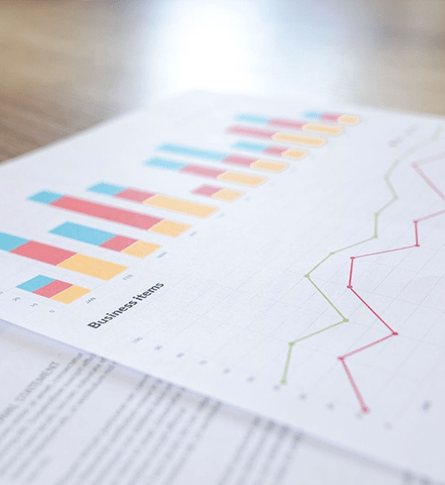Last month, Chelsea Groton hosted a virtual small business Lunch & Learn taught by Randy Wyrofsky, CPA, on the merits and methods of financial forecasting, with a focus on incorporating scenario analysis to better grasp future financial needs, which may have drastically changed over the past year.
“The Bank’s mission is to help customers and communities achieve their specific goals by taking them on as if they were our own. One way we do that is by providing education to the business community on issues that help them manage and grow their business,” explained Alexis Kahn, VP, Cash Management Sales Manager at Chelsea Groton Bank. “Given all the financial uncertainty that business owners have faced during Covid, the topic of financial forecasting is particularly relevant as owners assess how the pandemic has affected their business over the past year and create plans that will enable them to thrive within the ‘new normal.’”
For those who were unable to join us, here are a few key takeaways from the class:
Why Does Financial Forecasting Matter?
As you plan the trajectory of your business, whether it’s re-opening, pivoting your business type, purchasing additional equipment, or hiring or re-hiring employees, the financial forecast provides the framework to determine if the goal is achievable. If you plan to finance your business with the help of a loan, the forecast allows you to determine whether your business can support the monthly debt service, or whether an injection of equity would make better financial sense.
In addition, the financial forecasts you produced prior to 2020 may no longer be reliable representations of your business model. By going through the process of creating a robust financial forecast, you are able to tease out the factors that will need to change in order to make your go-forward goals viable. In addition, businesses can help alleviate uncertainty about available working capital needs by conducting financial forecasts on a shorter-term basis, rather than the more standard annual exercise. For those businesses that have been significantly impacted by the pandemic, monthly or even weekly forecasts may be appropriate.
So, How Do I Do It?
The elements to a financial forecast are the Balance Sheet, the Income Statement and the Cash Flow Statement. The assets of the Balance Sheet drive revenue, with the objective to maintain the minimum level of assets to generate the maximum revenue. By contrast, the Income Statement shows the financial impact of the business operations, while the Cash Flow Statement demonstrates whether the business has sufficient funds to continue operating.
Forecasting relies on historical performance of your own business, coupled with projected industry forecasts and trends, in order to model out what you expect to happen.
To create your financial forecast, try the following steps:
- Forecast revenues.
- Forecast the expenses to earn those revenues.
- Forecast the impact on the assets as a result of the forecast.
- Forecast the impact on liabilities and equity as a result of the forecast.
- Determine whether there is sufficient capital to operate the business.
Pay particular attention to trends in the Income Statement during the past year that may help determine how the business may perform in 2021 and even 2022. For example, many businesses have seen expenses rise significantly – whether from the higher cost of supplies or large purchases of PPE equipment – so these are important elements to consider as part of the forecast. In addition, while growth is always perceived as good, it’s important to consider the working capital requirements growth represents to ensure you have enough cash to support a booming business.
In addition, you should stress test your business with a base case, worst case and best case. Stress scenarios include inflation or an interruption in your supply chain, so that you can better understand the impact on your cash flow and income. A significant component of financial forecasting is testing assumptions under stress factors – such as a pandemic or extended shutdowns – to help develop contingency plans. For example, in the event that owners or a majority of key employees fall ill, developing a succession as well as staffing plans will help ensure business continuity in the face of such stress scenarios.
Moreover, be sure to avoid two common pitfalls in financial forecasting: 1) eliminate your own personal bias on how you expect your business to perform; and 2) if you use historical trends as the basis of your assumptions without giving proper consideration to whether they make sense, you can end up with highly improbable forecasts. For example, if you started your apparel business buying fabric from a local high-cost manufacturer and the following year changed to a low-cost supplier in a different geographical location, you should not project out such a significant year-over-year percentage drop in cost of goods sold in the future. It is recommended to have a trusted advisor, such as your CPA, review your forecast to challenge your own biased assumptions.
Financial forecasts are a powerful tool that provide clear insight into where the opportunities and the vulnerabilities are in your business model. As you learn about changes in your industry, or hear about economic predictions, you can change the assumptions in your forecast to make more informed decisions in order to position your business for future success. It is particularly critical to introduce these assumptions regularly into your financial forecasting given the changing economic landscape as Covid restrictions loosen and businesses adjust to the “new normal.”

Want to Learn More?
Check out a replay of the Financial Forecasting virtual session on Chelsea Groton’s YouTube channel.
If you would like to request the sample financial forecasting model built by Randy Wyrofsky, or the corresponding PowerPoint presentation, please reach out to Alexis Kahn at akahn@chelseagroton.com.
